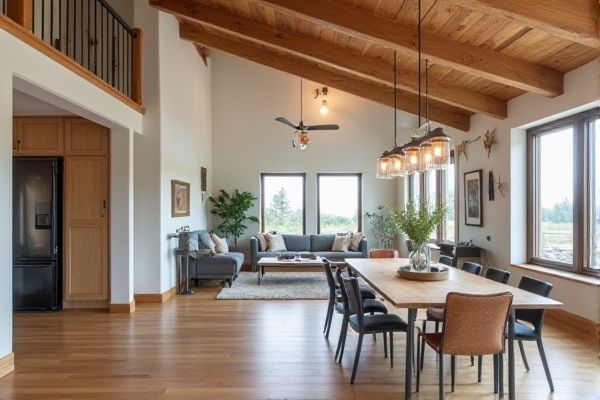
Ladderback and crossback chairs differ primarily in their backrest design, where ladderback features horizontal slats, offering a classic, sturdy look, while crossback incorporates intersecting diagonal bars for a more decorative style. Discover which option better suits Your space and aesthetic by reading the rest of the article.
Table of Comparison
| Feature | Ladderback | Crossback |
|---|---|---|
| Design | Horizontal slats resembling a ladder | Intersecting diagonal slats forming an "X" shape |
| Support | Offers firm back support with straight slats | Provides strong, flexible support with crossed slats |
| Style | Traditional, rustic, and classic | Modern, industrial, and farmhouse |
| Comfort | Moderate comfort with supportive back structure | Enhanced comfort due to flexible back design |
| Durability | Sturdy and long-lasting with solid wood slats | Durable with reinforced cross patterns |
| Common Usage | Dining chairs, traditional interiors | Dining chairs, casual and contemporary spaces |
Introduction to Ladderback and Crossback Chairs
Ladderback chairs feature horizontal slats across the backrest, offering classic support and a sturdy wooden frame ideal for rustic or traditional settings. Crossback chairs showcase an X-shaped design on the backrest, blending elegant style with structural stability often favored in farmhouse and modern decor. Both types emphasize comfort and durability, making them popular choices for dining and seating solutions.
Historical Background and Origins
The ladderback chair, originating in 17th-century England, features horizontal slats on the backrest that provided sturdy support and practicality for everyday use. In contrast, the crossback chair, with intersecting diagonal supports forming an "X," traces its roots to French bistro culture of the 19th century, blending rustic charm with elegant design. Both styles reflect distinct historical contexts--ladderback embracing early craftsmanship and utility, while crossback showcases a transition to decorative yet functional seating.
Design Differences: Ladderback vs Crossback
Ladderback chairs feature a simple, vertical slat design that resembles a ladder, providing a classic and sturdy look ideal for traditional settings. Crossback chairs, also known as X-back chairs, exhibit intersecting diagonal slats forming an "X" shape on the backrest, offering a more decorative and rustic appeal. These design differences impact both the aesthetic and structural characteristics, making ladderbacks typically more rigid and crossbacks often preferred for their visual interest in farmhouse or vintage decor.
Materials Used in Both Chair Styles
Ladderback chairs typically feature solid wood construction, often using hardwoods like oak, maple, or cherry, prized for durability and classic grain patterns. Crossback chairs combine solid wood or metal frames, with popular materials including oak, ash, or iron, providing a rustic yet sturdy aesthetic. Both styles often incorporate woven rush or cane seats, enhancing comfort and traditional appeal.
Aesthetic Appeal: Ladderback vs Crossback
Ladderback chairs feature a traditional, linear slat design that offers a timeless, rustic charm ideal for farmhouse or classic interiors. Crossback chairs present an intersecting X-pattern on the backrest, contributing to a more modern, sophisticated aesthetic favored in contemporary and industrial-style spaces. Both designs enhance visual interest, but ladderback emphasizes simplicity and heritage, while crossback highlights geometric elegance and trendiness.
Comfort and Functionality Comparison
Ladderback chairs offer firm support with their horizontal slats, providing excellent posture alignment, making them ideal for extended seating periods. Crossback chairs feature a curved X-shaped backrest that enhances lumbar comfort and adds flexibility, adapting well to various body shapes. Functionally, ladderbacks excel in durability and stability, while crossbacks prioritize ergonomic comfort and aesthetic appeal in both dining and office settings.
Versatility in Interior Décor
Ladderback chairs offer a timeless design with clean, vertical slats that blend seamlessly into traditional and rustic interior decor, complementing wooden furniture and farmhouse styles. Crossback chairs provide a more dynamic visual interest with their intersecting "X" design, enhancing contemporary, industrial, or coastal themes with a touch of elegance. Both options serve as versatile seating choices that adapt well to various color schemes, materials, and room aesthetics, making them popular in kitchen, dining, and event settings.
Durability and Maintenance
Ladderback chairs, with their sturdy vertical slats and solid wood construction, offer exceptional durability and often require minimal maintenance, making them ideal for long-term use. Crossback chairs feature a crisscross design that provides robust support but may need more frequent upkeep to preserve the finish and structural integrity, especially in outdoor settings. Your choice between ladderback and crossback chairs should consider the balance between durability demands and the ease of maintenance to ensure lasting appeal.
Price Range and Affordability
Ladderback chairs typically fall within a lower price range, offering a more affordable option for budget-conscious buyers due to their simpler design and widespread availability. Crossback chairs often come at a higher price point, reflecting their intricate craftsmanship and trendier aesthetic favored in upscale settings. Your choice depends on balancing cost considerations with the desired style and durability for your space.
Choosing the Right Chair for Your Space
Ladderback chairs feature vertical slats, offering classic support and a traditional aesthetic that suits rustic or farmhouse-style interiors. Crossback chairs, characterized by their intersecting X-shaped design, provide a modern, stylish look ideal for contemporary or industrial spaces. Your choice depends on the desired ambiance and comfort level for your dining or living area.
 homyna.com
homyna.com